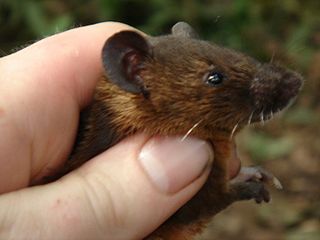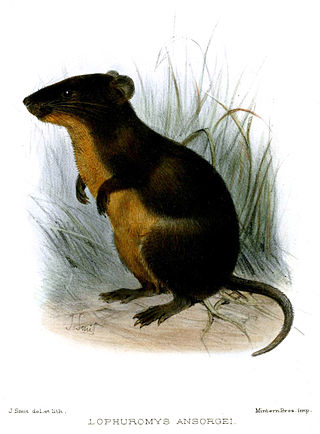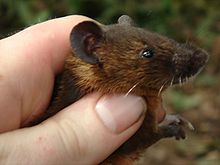
The Muridae, or murids, are the largest family of rodents and of mammals, containing approximately 1,383 species, including many species of mice, rats, and gerbils found naturally throughout Eurasia, Africa, and Australia.

The subfamily Deomyinae consists of four genera of mouse-like rodents that were placed in the subfamilies Murinae and Dendromurinae until very recently. They are sometimes called the Acomyinae, particularly in references that antedate the discovery that the link rat, Deomys ferugineus, is part of the clade. Deomyinae is the older name and therefore has priority over Acomyinae.

The brush-furred mice, genus Lophuromys are a group of rodents found in sub-Saharan Africa. They are members of the subfamily Deomyinae, a group only identifiable through molecular analysis. Lophuromys is also known as the brush-furred rats, harsh-furred rats or coarse-haired mice.

Percival's spiny mouse is a species of rodent in the family Muridae. It is found in Kenya, Somalia, South Sudan, and Uganda. Its natural habitats are dry savanna, subtropical or tropical dry shrubland, and rocky areas. It is one of two known species of mammals, the other being Acomys kempi, capable of completely regenerating damaged tissue, including hair follicles, skin, sweat glands, fur and cartilage.
The West African shaggy rat is a species of rodent in the family Muridae. It is found in Benin, Cameroon, Ivory Coast, Gambia, Ghana, Guinea, Guinea-Bissau, Liberia, Mali, Nigeria, Senegal, Sierra Leone, and Togo. Its natural habitats are subtropical or tropical seasonally wet or flooded lowland grassland and swamps. It is a common species and the International Union for Conservation of Nature has rated its conservation status as being of "least concern".

The woodland thicket rat is a species of rodent in the family Muridae. It is found in Angola, Burundi, Democratic Republic of the Congo, Kenya, Malawi, Mozambique, Rwanda, South Africa, South Sudan, Eswatini, Tanzania, Zambia, and Zimbabwe. Its natural habitats are subtropical or tropical dry forest, subtropical or tropical moist lowland forest, subtropical or tropical dry shrubland, subtropical or tropical moist shrubland, subtropical or tropical high-altitude shrubland, subtropical or tropical dry lowland grassland, arable land, pastureland, and urban areas.
The short-tailed brush-furred rat is a species of rodent in the family Muridae. It is found only in Ethiopia. Its natural habitats are subtropical or tropical high-altitude shrubland and subtropical or tropical high-altitude grassland. It is threatened by habitat loss.
The Ethiopian forest brush-furred rat or golden-footed brush-furred rat, is a species of rodent in the family Muridae. It is endemic to Ethiopia where its natural habitat is subtropical or tropical moist montane forests. It is threatened by habitat loss.
The gray brush-furred rat is a species of rodent in the family Muridae. It is found only in Democratic Republic of the Congo. Its natural habitats are subtropical or tropical swamps, subtropical or tropical moist montane forests, and subtropical or tropical high-altitude grassland. It is threatened by habitat loss.
The yellow-spotted brush-furred rat is a species of rodent in the family Muridae found in Angola, the Democratic Republic of the Congo, Ethiopia, Kenya, Malawi, Mozambique, South Sudan, Tanzania, and Zambia. Its natural habitats are subtropical or tropical moist lowland forest, subtropical or tropical moist montane forest, and subtropical or tropical high-altitude grassland. The population in Ethiopia is isolated and can be found at high altitudes up to 4,500 m above sea level.
Hutterer's brush-furred mouse or Hutterer's brush-furred rat is a species of rodent in the family Muridae. It is found only in Democratic Republic of the Congo, where its natural habitat is subtropical or tropical moist lowland forests.
The fire-bellied brush-furred rat is a species of rodent in the family Muridae. It is found in Cameroon, Central African Republic, the Republic of the Congo, the Democratic Republic of the Congo, Equatorial Guinea, and Gabon. Its natural habitat is subtropical or tropical moist lowland forests.
The Mount Cameroon brush-furred rat or Rosevear's brush-furred mouse is a species of rodent in the family Muridae. It is found only in Cameroon. Its natural habitats are subtropical or tropical moist montane forests, subtropical or tropical moist shrubland, subtropical or tropical high-altitude shrubland, subtropical or tropical high-altitude grassland, plantations, and rural gardens.

The Natal multimammate mouse is a species of rodent in the family Muridae. It is also known as the Natal multimammate rat, the common African rat, or the African soft-furred mouse. The Natal multimammate rat is the natural host of the Lassa fever virus.

Salvin's spiny pocket mouse is a small to medium-sized rodent in the family Heteromyidae. It was formerly placed in the genus Liomys, which is now recognized to be paraphyletic and has been subsumed into Heteromys.

The northern grasshopper mouse is a North American carnivorous rodent of the family Cricetidae. It ranges over much of the western part of the continent, from southern Saskatchewan and central Washington to Tamaulipas in northeast Mexico.
The Angolan brush-furred rat is a species of brush-furred mouse found in Angola and the southwest of the Democratic Republic of Congo.

Ansorge's brush-furred rat is a species of rodent in the family Muridae. It was identified in 1896 by de Winton as L. ansorgei. However, it was widely regarded as L. sicapusi until 2000, when Walter Verheyen, Theo Dierckx, and Jan Hulselmans published a study to the Bulletin of the Royal Belgian Institute of Natural Sciences describing it as a distinct species.









